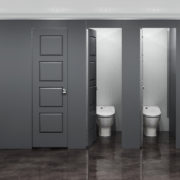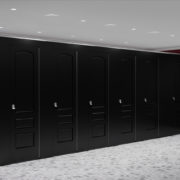What’s the CORE Problem in Restrooms?
There are many choices when choosing a material for your bathroom partitions. Before making a decision take a closer look at whats inside!
Material Options
The five main material options when choosing a bathroom partition are; Plastic laminate, Phenolic (black core), Stainless Steel, Baked Enamel, and Solid Plastic. All of these material choices vary in cost and have different cost of ownership models.
My Core is What?
Plastic laminate partitions are made from particle board and finished in a plastic laminate surface.
Phenolic (black core) partitions are compression molded; made from many layers of decorate papers which are saturated with phenolic resin. This forms the base which is then laminated with heat.
Stainless Steel partitions are generally manufacturered with a honey comb or wood core glued under pressure to #304 stainless steel sheets and assembled with roll formed molding.
Powder coated steel or baked enamel is a hybrid epoxy / polyester powder coated finished over galvanized steel is fabricated with roll formed molding and a honeycomb or woodcore.
Solid plastic is made from a polymer composed from extruded resin and is solid throughout.
How Cores Affect You
A source of potentially harmful air quality issues occur with exposure to mold, mildew and fungus.
Veneer exterior, particle board and honeycomb cardboard cores are at high risk for moisture penetration. This risk increases dramatically when these materials are placed in damp and wet environments such as shower rooms and restrooms.
Laminated or hollow core materials cannot be installed without penetrating the veneer exterior, exposing the interior to moisture and potentially water. This can create a harmful condition whereby the core of the partition becomes exposed to moisture while the thin veneer remains seemingly intact. As the core begins to mold and deteriorate, the integrity of both the air quality and partition structure are compromised.
This could result in an unforeseen hazardous and costly mold problem. This is particularly true in rooms with increased humidity such as showers, restrooms and locker rooms
Utilizing solid surfacing materials such as HDPE contributes to better indoor air quality as the solid, non-porous property of these materials resist the growth of mold and mildew.






